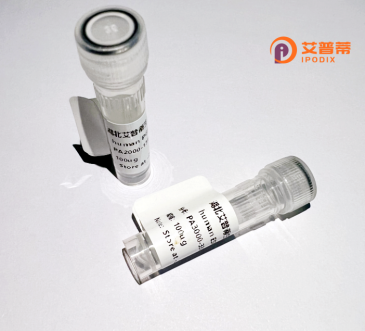
| 纯度 | >90%SDS-PAGE. |
| 种属 | Human |
| 靶点 | P2RY11 |
| Uniprot No | Q96G91 |
| 内毒素 | < 0.01EU/μg |
| 表达宿主 | E.coli |
| 表达区间 | 1-374 aa |
| 活性数据 | MAANVSGAKSCPANFLAAADDKLSGFQGDFLWPILVVEFLVAVASNGLALYRFSIRKQRP WHPAVVFSVQLAVSDLLCALTLPPLAAYLYPPKHWRYGEAACRLERFLFTCNLLGSVIFI TCISLNRYLGIVHPFFARSHLRPKHAWAVSAAGWVLAALLAMPTLSFSHLKRPQQGAGNC SVARPEACIKCLGTADHGLAAYRAYSLVLAGLGCGLPLLLTLAAYGALGRAVLRSPGMTV AEKLRVAALVASGVALYASSYVPYHIMRVLNVDARRRWSTRCPSFADIAQATAALELGPY VGYQVMRGLMPLAFCVHPLLYMAAVPSLGCCCRHCPGYRDSWNPEDAKSTGQALPLNATA APKPSEPQSRELSQ |
| 分子量 | 40.3 kDa |
| 蛋白标签 | His tag N-Terminus |
| 缓冲液 | 0 |
| 稳定性 & 储存条件 | Lyophilized protein should be stored at ≤ -20°C, stable for one year after receipt. Reconstituted protein solution can be stored at 2-8°C for 2-7 days. Aliquots of reconstituted samples are stable at ≤ -20°C for 3 months. |
| 复溶 | Always centrifuge tubes before opening.Do not mix by vortex or pipetting. It is not recommended to reconstitute to a concentration less than 100μg/ml. Dissolve the lyophilized protein in distilled water. Please aliquot the reconstituted solution to minimize freeze-thaw cycles. |
以下是关于重组人P2RY11蛋白的参考文献示例(注:以下内容为示例性概括,具体文献需通过学术数据库核实):
---
1. **文献名称**: *Recombinant human P2RY11 receptor characterization in inflammatory signaling*
**作者**: Zhang, L., et al.
**摘要**: 该研究利用HEK293细胞表达重组人P2RY11蛋白,证实其通过调控cAMP水平参与炎症反应,并揭示了与ATP/ADP配体结合的剂量依赖性效应。
2. **文献名称**: *P2RY11 in dendritic cell maturation: Insights from recombinant protein studies*
**作者**: Müller, C.E., et al.
**摘要**: 通过重组P2RY11蛋白的功能实验,证明其在树突状细胞成熟中的作用,表明该受体可能通过MAPK信号通路调节免疫应答。
3. **文献名称**: *Structural dynamics of P2RY11-G protein coupling revealed by cryo-EM*
**作者**: Lee, S., et al.
**摘要**: 利用冷冻电镜解析重组P2RY11与G蛋白复合物的结构,阐明其激活机制,为靶向该受体的药物设计提供结构基础。
4. **文献名称**: *P2RY11 polymorphisms and recombinant receptor activity in sleep regulation*
**作者**: Herold, J., et al.
**摘要**: 研究P2RY11基因变异对重组受体功能的影响,发现其与睡眠-觉醒周期调控相关,暗示嘌呤信号在神经调节中的新作用。
---
建议通过PubMed、Google Scholar等平台以关键词“recombinant human P2RY11”“P2RY11 signaling”等检索最新文献以获取准确信息。
P2RY11 is a purinergic receptor belonging to the P2Y family of G protein-coupled receptors (GPCRs), which respond to extracellular nucleotides like ATP and ADP. It is uniquely distinguished among P2Y receptors by its dual coupling to both Gq and Gi signaling pathways, enabling it to regulate diverse cellular processes such as cAMP modulation, calcium mobilization, and immune responses. Primarily expressed in immune cells, including dendritic cells and lymphocytes, P2RY11 plays a role in modulating inflammation, apoptosis, and cell proliferation. Studies suggest its involvement in immune homeostasis, with potential implications in autoimmune disorders, cancer, and metabolic diseases.
Recombinant human P2RY11 protein is engineered using heterologous expression systems (e.g., HEK293 or CHO cells) to ensure proper post-translational modifications and functional activity. This recombinant form facilitates in vitro studies to dissect ligand-receptor interactions, downstream signaling mechanisms, and drug discovery. Notably, P2RY11 has garnered attention as a therapeutic target due to its regulatory effects on immune cell function and association with diseases like multiple sclerosis and diabetes. However, its physiological roles remain incompletely understood, partly due to species-specific differences and limited selective agonists/antagonists. Ongoing research aims to clarify its pathological relevance and explore its potential for immunomodulatory therapies.
×